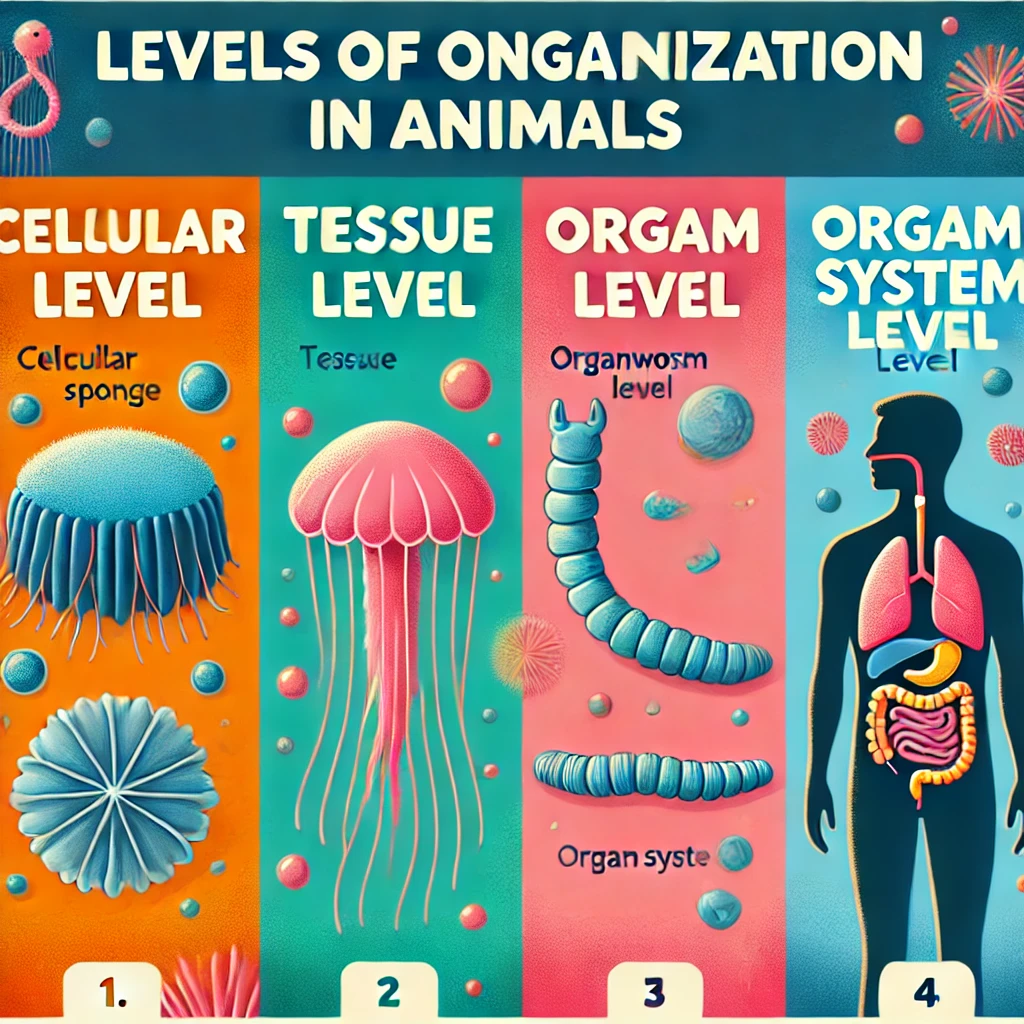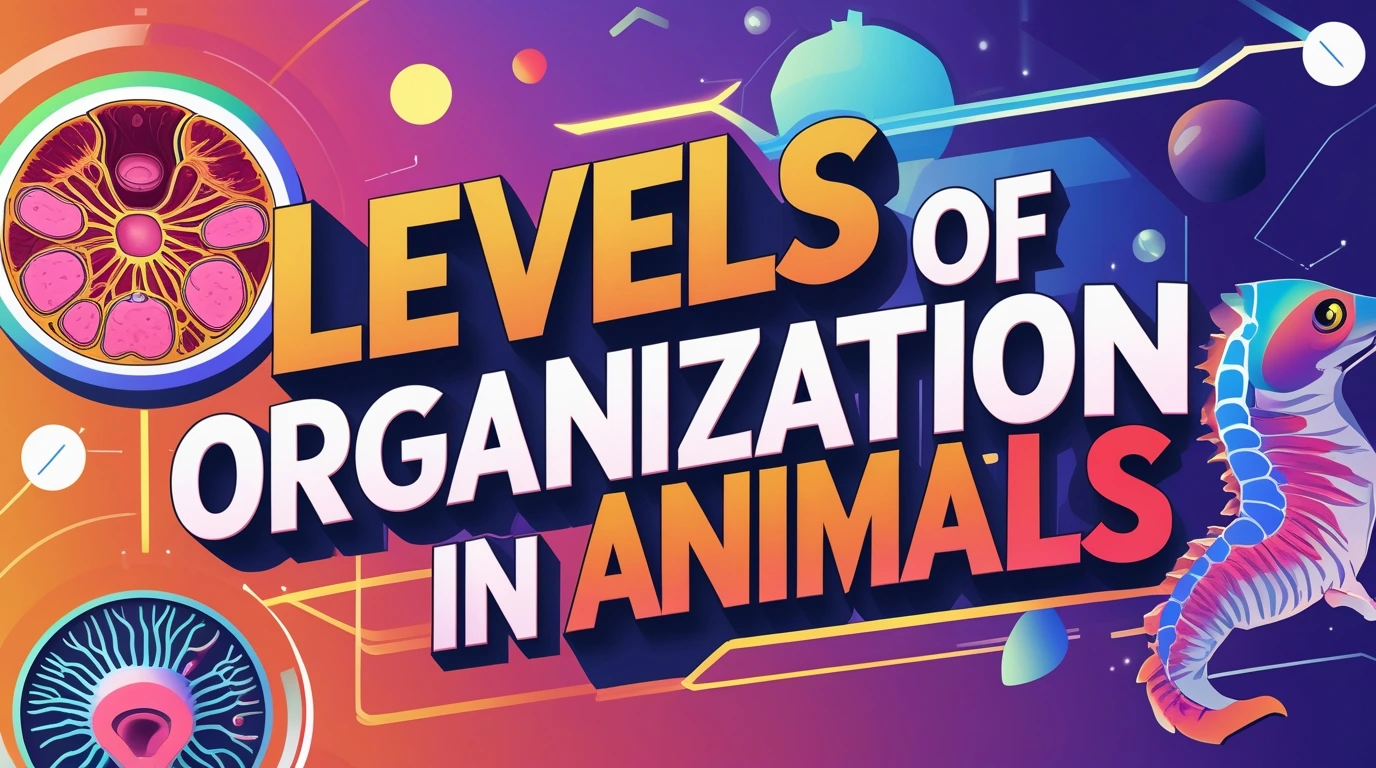Learn the levels of organization in animals
The body structure of animals becomes more complex as we move from simple animals to Higher animals. Animals are classified based on how their cells, tissues, organs, and systems are organized. This is called level of organization.
Table of Contents
There are 4 types of levels of organization in animals-
1-Cellular Level of Organization
In these animals, the body is made up of cells. The cells are loosely arranged and do not form tissues. Each cell performs its work. An example is sponges (Phylum: Porifera).
Think of it like: A group of people working individually without forming a team.
2. Tissue Level of Organization
- The cells group to form tissues.
- A tissue is a group of similar cells that work together to perform a function.
- Tissues perform specific tasks but do not form organs.
- Example: Jellyfish and Hydra (Phylum: Cnidaria).
Think of it like: A small team where everyone does the same task.
3. Organ Level of Organization
- The tissues combine to form organs.
- Each organ performs a specific function (e.g., stomach for digestion).
- But there is no proper system where organs work together as a group.
- Example: Flatworms (Phylum: Platyhelminthes).
Think of it as different teams, each doing a specific job, like a food or cleaning team.
4. Organ System Level of Organization
- The organs group to form an organ system.
- Organ systems work together to perform complex functions (e.g., digestion, breathing).
- This is the most advanced level of organization.
- Example: Humans, Fish, Birds, and Insects.
Think of it like: A large company with different departments (like sales, HR, and finance) working together to keep the company running.
Summary Table
| Level of Organization | What it means? | Examples |
|---|---|---|
| Cellular Level | The body is made of loosely arranged cells. | Sponges |
| Tissue Level | Cells form tissues but no organs. | Jellyfish, Hydra |
| Organ Level | Tissues form organs. | Flatworms |
| Organ System Level | Organs work together as systems. | Humans, Fish, Birds |
In simple terms:
- Cells form → Tissues.
- Tissues form → Organs.
- Organs form → Organ Systems.
This gradual increase in complexity is what we call the levels of organization in animals. 😊

Frequently Asked Questions (FAQs)
1. What are the levels of organization in animals?
The levels of organization in animals describe the arrangement of cells, tissues, organs, and organ systems in the body. It includes:
- Cellular Level: Individual cells (e.g., sponges).
- Tissue Level: Cells form tissues (e.g., jellyfish).
- Organ Level: Tissues form organs (e.g., flatworms).
- Organ System Level: Organs form systems (e.g., humans).
2. Why is the classification of animals important?
Classification helps organize animals into groups, making it easier to:
- Study their features systematically.
- Identify new species.
- Understand the evolutionary relationships between animals.
3. What is the simplest level of organization in animals?
The simplest level of organization is the cellular level, where the body is made up of loosely arranged cells. An example is sponges (Phylum Porifera).
4. What is the difference between tissue level and organ level of organization?
- Tissue Level: Cells group to form tissues, but no organs are present. Example: Jellyfish (Phylum Cnidaria).
- Organ Level: Tissues group to form organs, but organ systems are not yet developed. Example: Flatworms (Phylum Platyhelminthes).
5. Which animals show organ system level of organization?
Animals like humans, fish, birds, and insects exhibit the organ system level of organization, where organs work together to perform specific functions.
6. How does the complexity of animals increase in the animal kingdom?
The complexity increases in the following order:
- Cellular Level → Tissue Level → Organ Level → Organ System Level.
Each level shows a more advanced body structure and function.
7. What are examples of animals at each level of organization?
- Cellular Level: Sponges (Porifera).
- Tissue Level: Jellyfish, Hydra (Cnidaria).
- Organ Level: Flatworms (Platyhelminthes).
- Organ System Level: Humans, Earthworms, Fish, and Birds.
8. What are germ layers in animals?
Germ layers are layers of cells that develop during an animal’s early growth:
- Diploblastic: Two layers (ectoderm, endoderm). Example: Jellyfish.
- Triploblastic: Three layers (ectoderm, mesoderm, endoderm). Example: Humans.
